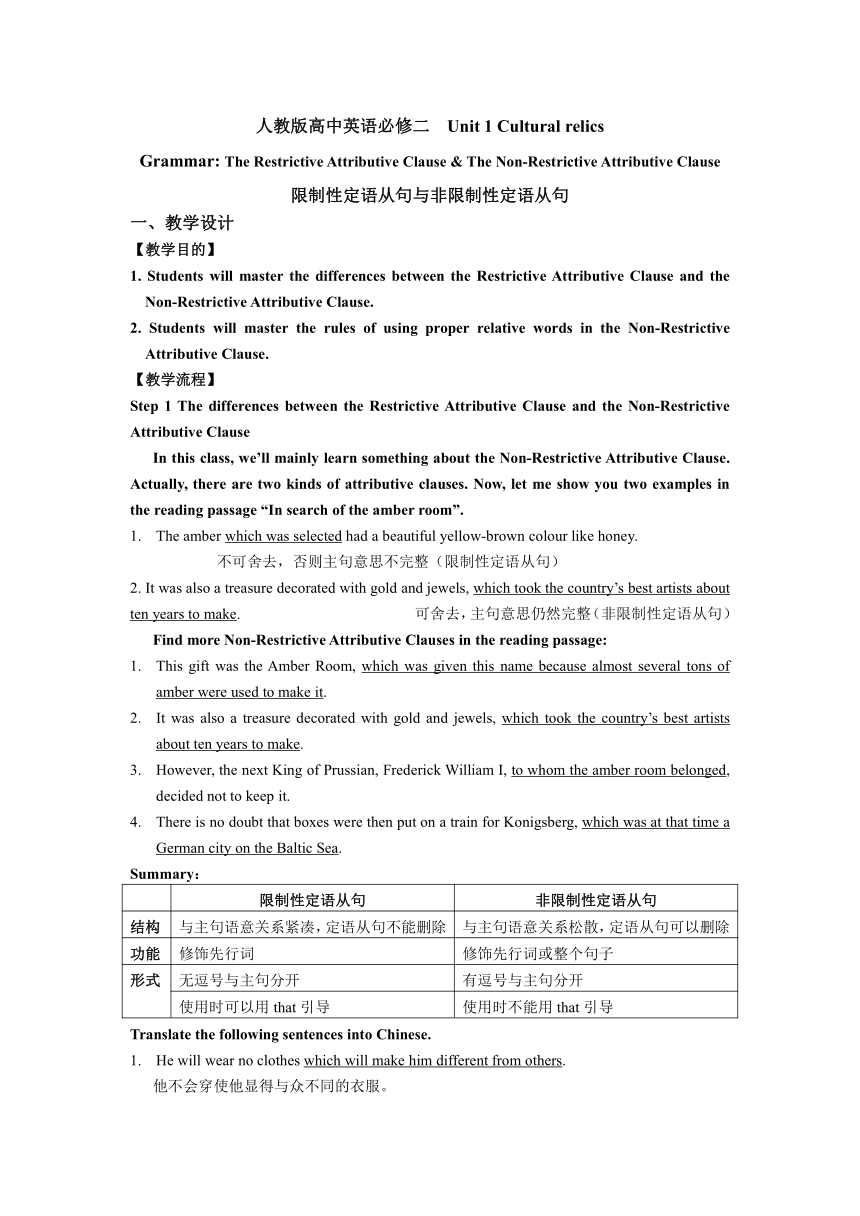
人教版高中英语必修二 Unit 1 Cultural relics Grammar: The Restrictive Attributive Clause & The Non-Restrictive Attributive Clause 限制性定语从句与非限制性定语从句 一、教学设计 【教学目的】 1. Students will master the differences between the Restrictive Attributive Clause and the Non-Restrictive Attributive Clause. 2. Students will master the rules of using proper relative words in the Non-Restrictive Attributive Clause. 【教学流程】 Step 1 The differences between the Restrictive Attributive Clause and the Non-Restrictive Attributive Clause In this class, we’ll mainly learn something about the Non-Restrictive Attributive Clause. Actually, there are two kinds of attributive clauses. Now, let me show you two examples in the reading passage “In search of the amber room”. The amber which was selected had a beautiful yellow-brown colour like honey. 不可舍去,否则主句意思不完整(限制性定语从句) 2. It was also a treasure decorated with gold and jewels, which took the country’s best artists about ten years to make. 可舍去,主句意思仍然完整(非限制性定语从句) Find more Non-Restrictive Attributive Clauses in the reading passage: This gift was the Amber Room, which was given this name because almost several tons of amber were used to make it. It was also a treasure decorated with gold and jewels, which took the country’s best artists about ten years to make. However, the next King of Prussian, Frederick William I, to whom the amber room belonged, decided not to keep it. There is no doubt that boxes were then put on a train for Konigsberg, which was at that time a German city on the Baltic Sea. Summary: 限制性定语从句 非限制性定语从句 结构 与主句语意关系紧凑,定语从句不能删除 与主句语意关系松散,定语从句可以删除 功能 修饰先行词 修饰先行词或整个句子 形式 无逗号与主句分开 有逗号与主句分开 使用时可以用that引导 使用时不能用that引导 Translate the following sentences into Chinese. He will wear no clothes which will make him different from others. 他不会穿使他显得与众不同的衣服。 He will wear no clothes, which will make him different from others. 他不穿衣服,这会使他显得与众不同。 She has two brothers who are working in the city. 她有两个在这个城市工作的弟弟。 She has two brothers, who are working in the city. 她有两个弟弟,他们在这个城市工作。 Step 2 Rules about the Non-Restrictive Attributive Clause Next,let’s explore some rules in the use of relative words in the Non-Restrictive Attributive Clause. Look at the following sentences. He gave me a gift, which he bought yesterday. He passed the exam, which made his parents happy. Rule1: 非限制性定语从句, 先行词是事、物,关系词只能用which,不用that,不省略。 Do you know Tom, whom we talked about Rule2: 非限制性定语从句, 先行词是人, 关系词只能用who/whom,不用that,不省略。 I told them the reason, for which I hadn’t attended the meeting. Rule3: 非限制性定语从句,不能用why引导,要用for which代替。 They have four children, the daughter of whom is working in that big company now. Rule4: 非限制性定语从句由“介词+ ... ...
~~ 您好,已阅读到文档的结尾了 ~~